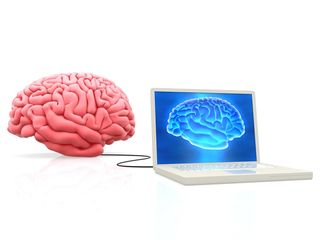Memory
The Brain-Computer Interface Is Coming
Shock therapy, direct brain stimulation, and a brain modem to hack your thoughts
Posted March 30, 2019 Reviewed by Matt Huston

Shock therapy, better known as Electroconvulsive Therapy (ECT), sends electricity into the brain to induce seizures in depressed patients who don’t respond to other treatments. In many such cases, ECT does provide relief. ECT has been around since 1938, and is a relatively safe and effective intervention for major depression, still in use today. This idea of applying electricity to the brain is not new, but it is taking some exciting new turns.
Brain implants? Are you ready to upgrade your biological operating system by connecting technology directly to your brain? The idea of neural implantation is also not new. Dr. William House surgically inserted the first cochlear implant in 1961. Most considered his idea to tap into a deaf person’s auditory nerve radical and invasive. Today, thousands of formerly deaf patients around the world now have the ability to hear because of cochlear implants.
Neural implants also work for treating Parkinson’s. For several years, deep-brain stimulation (DBS) has been used to treat this neurological disorder. Multiple studies confirm the efficacy of DBS to improve Parkinson’s patients’ symptoms and quality of life. DBS has since been tested for chronic pain relief, substance abuse, obesity, depression, obsessive-compulsive disorder, and Tourette’s.
DBS delivers a small electric current to change the activity of specific brain areas. Like a pacemaker for the mind, this electrical stimulation of the brain with implanted electrodes appears to reduce symptoms for several difficult-to-treat disorders. A little bit of electrical current apparently goes a long way.

What’s next? Since the 1970s, researchers have been working on the “brain-computer interface” (BCI). Unlike the neural implants above, which supply electric current, BCI allows for the bidirectional flow of information. That means your brain will be able to send and receive information … not communicating through your eyes, ears, or fingers, but instead through a direct electrical connection wired into your brain. Imagine your brain hooked directly to a computer! Researchers have already started tested a brain implant to improve long-term memory. One possible therapeutic will use such devices to enhance memory for those who’ve sustained brain injury resulting in amnesia or other memory problems. This may be the beginning of an implantable “memory prosthesis.”
Is your brain ready for plug-and-play? In fact, government and private research labs are working on a “brain modem,” a very high-bandwidth BCI connection between the brain and other devices, to treat anything from blindness to paralysis. This type of direct brain-computer connection is not that far into the future. A company called Paradromics is working on a high-density connection to the brain’s speech center to literally hack into and decode the words that a person is thinking of saying. Recently, according to an article in the MIT Technology Review, Elon Musk announced funding for Neuralink, a company working on a brain-computer interface. And then Facebook followed by announcing it’s working on a “thought-to-text” device to allow us to silently compose a text or email, just by thinking it!
In a not-too-distant future, your thoughts themselves may become commands to control technology in a brave new world that is no longer science fiction. What’s next? Psychology through technology continues its exponential evolution.
References
Perestelo-Pérez, L., Rivero-Santana, A., Pérez-Ramos, J. et al. (2014). Deep brain stimulation in Parkinson’s disease: meta-analysis of randomized controlled trials. J Neurology, 261: 2051. https://doi.org/10.1007/s00415-014-7254-6
Kringelbach ML, Jenkinson N, Owen SL, Aziz TZ (August 2007). "Translational principles of deep brain stimulation". Nature Reviews. Neuroscience. 8 (8): 623–35. doi:10.1038/nrn2196. PMID 17637800
Hammond C, Ammari R, Bioulac B, Garcia L (2008). Latest view on the mechanism of action of deep brain stimulation. Movement Disorders. 23 (15): 2111–21. doi:10.1002/mds.22120. PMID 18785230


